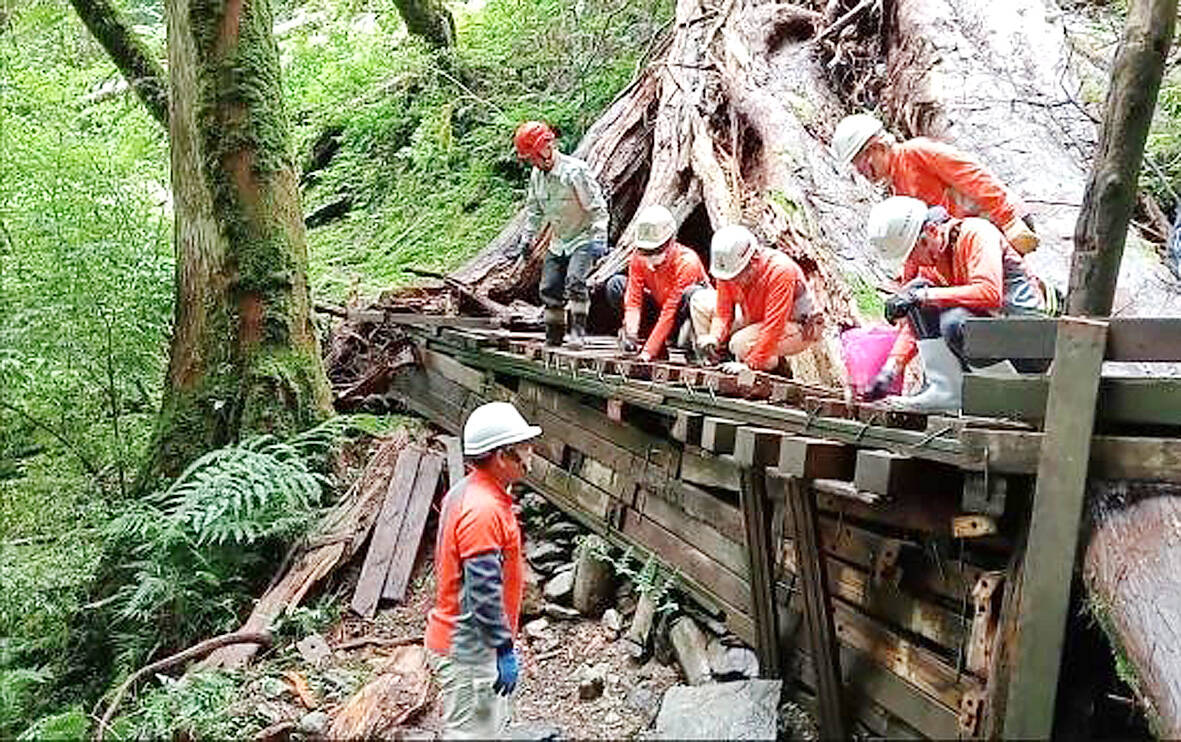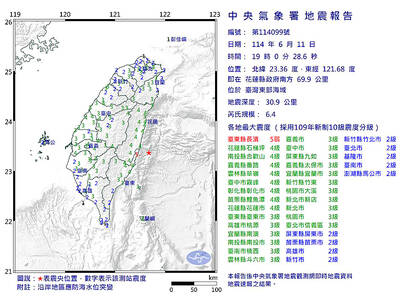People hiking through Taoyuan’s new Lalashan (拉拉山) National Forest Recreation Area might not realize they are walking on rock and wood taken from the surrounding area by volunteers who restored the trail using traditional methods.
The recreation area opened in April, beckoning hikers with its forest footpaths, including one known as the “handmade trail,” which snakes past the mountain’s “giant tree area” home to Taiwan cypress and Taiwan red cypress trees.
The trail, at an altitude of 2,200m, took eight years to complete by a group of volunteers, working under the guidance of the Forestry Bureau’s Hsinchu Forest District Office.

Photo courtesy of the Hsinchu Forest District Office.
The group was initially formed in 2013 and currently has 62 members whose ages range from their 20s to their 70s. They hail from across Taiwan and are joined by their shared love of hiking. Group members come from diverse backgrounds, including retired military officers, professors, high-tech executives, taxi drivers and farm owners.
Former team leader Lin Kuo-wen (林國文) said the members meet once a month, from Saturday to Monday, to work, survey and assess trail conditions, prepare tools and construction materials, lay down foundations and conduct maintenance on the trail.
The team has worked in several other national forest recreation areas, including Neidong (內洞) in New Taipei City’s Wulai District (烏來), as well as Manyueyuan (滿月圓), Dongyanshan (東眼山) and Guanwu (觀霧) in Hsinchu and Miaoli counties, he said.
The Lalashan area originally had trails covered with wooden boards, but the rainy and damp conditions in the mountain degraded the boards, which are not easy to maintain, Lin said.
The team began the renewal work on the footpath in 2015 to gradually turn it into what has become the “handmade trail,” he said, adding that the group ran into many issues.
“Oftentimes, we had already placed the rock foundation and the wooden boards in place, but had to remove and set them again, and other times, several group members had to work together a heavy boulder blocking the trail,” he said.
Many of the group’s members also slipped and fell on the narrow trail, sustaining injuries from thorny bushes, he added.
Hu Chiao-yun (胡僑芸), the team’s photographer, said the most challenging work came in early December 2020, with several days of heavy rain causing giant tree No. 23 to fall on a circular path.
Meanwhile, debris acculumated on a stream cut off access to giant tree Nos. 16 to 18 and damaged the path leading to giant tree No. 4, she said.
“Soon after, the COVID-19 pandemic began and we had to suspend out work to prevent infection. We resumed work in April last year, when the pandemic eased, but we had to rearrange the work units,” she added.
“When we launched new on-site surveillance, we found overgrown grass and brush, and some of the rock slabs and wooden boards we had placed were in disarray,” Hu said.
“When we saw the trail in that condition, we almost fainted right there,” she added.
“It took us four days to chisel the rocks and reset the slabs and wooden boards one by one. We also placed crushed stones to reinforce up the underlying foundation,” Hu said.
“Only then could we reconstruct the bridge for the trail to giant tree No. 23. Then we finished the climbing steps that lead to a viewing platform for giant tree No. 24,” she said.
Lin said the volunteer work had “no individual heroes. The results all came from teamwork.”
“We worked in mountainous forests at altitudes of 1,400m to 1,900m, often surrounded by fog. At times, it got really cold and we shivered in the wind, and other times the sun burned our skin,” he said.
However, “seeing the successful outcome gives us satisfaction, which overcomes physical fatigue,” he said.

A magnitude 6.4 earthquake struck off the coast of Hualien County in eastern Taiwan at 7pm yesterday, the Central Weather Administration (CWA) said. The epicenter of the temblor was at sea, about 69.9km south of Hualien County Hall, at a depth of 30.9km, it said. There were no immediate reports of damage resulting from the quake. The earthquake’s intensity, which gauges the actual effect of a temblor, was highest in Taitung County’s Changbin Township (長濱), where it measured 5 on Taiwan’s seven-tier intensity scale. The quake also measured an intensity of 4 in Hualien, Nantou, Chiayi, Yunlin, Changhua and Miaoli counties, as well as

Credit departments of farmers’ and fishers’ associations blocked a total of more than NT$180 million (US$6.01 million) from being lost to scams last year, National Police Agency (NPA) data showed. The Agricultural Finance Agency (AFA) said last week that staff of farmers’ and fishers’ associations’ credit departments are required to implement fraud prevention measures when they serve clients at the counter. They would ask clients about personal financial management activities whenever they suspect there might be a fraud situation, and would immediately report the incident to local authorities, which would send police officers to the site to help, it said. NPA data showed

ENERGY RESILIENCE: Although Alaska is open for investments, Taiwan is sourcing its gas from the Middle East, and the sea routes carry risks, Ho Cheng-hui said US government officials’ high-profile reception of a Taiwanese representative at the Alaska Sustainable Energy Conference indicated the emergence of an Indo-Pacific energy resilience alliance, an academic said. Presidential Office Secretary-General Pan Men-an (潘孟安) attended the conference in Alaska on Thursday last week at the invitation of the US government. Pan visited oil and gas facilities with senior US officials, including US Secretary of the Interior Doug Burgum, US Secretary of Energy Chris Wright, Alaska Governor Mike Dunleavy and US Senator Daniel Sullivan. Pan attending the conference on behalf of President William Lai (賴清德) shows a significant elevation in diplomatic representation,

The Taipei City Reserve Command yesterday initiated its first-ever 14-day recall of some of the city’s civilian service reservists, who are to undergo additional training on top of refresher courses. The command said that it rented sites in Neihu District (內湖), including the Taipei Tennis Center, for the duration of the camp to optimize tactical positioning and accommodate the size of the battalion of reservists. A battalion is made up of four companies of more than 200 reservists each, it said. Aside from shooting drills at a range in New Taipei City’s Linkou District (林口), the remainder of the training would be at